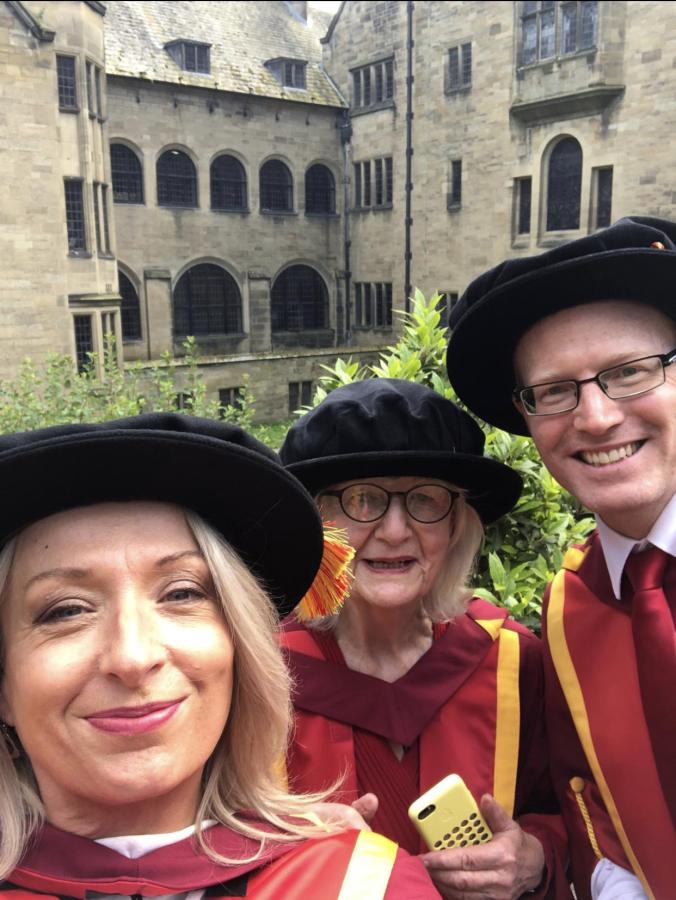Dr Meinir Moncrieffe & the identity of Sir John Wynn of Gwydir
This blog celebrates the achievements of our very own Dr Meinir Moncrieffe, who in July this summer, graduated from Bangor University as the Institute for the Study of Welsh Estate’s (ISWE) fifth successful PhD candidate.
Meinir’s thesis, ‘Perception and Projection: The Self-fashioning of Sir John Wynn of Gwydir’, explores the story of Sir John Wynn (1553 – 1627), and his efforts to promote the prestige and pedigree of the Wynn family, not only as one of the preeminent uchelwyr families of Wales, but to establish the family as an important player in the squirearchy of late-Tudor Britain.

For Meinir, a successful entrepreneur and businessperson, owning two hair and beauty salons in Criccieth, and Dolgellau the fall down the ‘history rabbit hole’ started with the story of a man and his dog. Starting her journey into academia as a mature student, Meinir followed her earliest passion, studying a degree in Art History at the Open University. From this she studied for an MA in Celtic Studies at the University of Wales Trinity Saint David where, by chance she discovered an intriguing letter written in Latin by one Sir John, in approximately 1592. This letter describes the Welsh myth of Gelert, who we all know as the loyal hound of Llywelyn ab Iorwerth who defended the prince’s infant son from a wolf attack, only to later be slain by his master in a tragic case of mistaken identity. The letter is the earliest written account of a dog named Gelert, however, the narrative is different from the well known legend, and thus piqued Meinir’s interest in the man behind the letter, and little wonder: Meinir had grown up surrounded by this timeless legend, and the myth-laden landscape of Nant Gwynant, having attended school in the village of Beddgelert, named for the faithful pup at the centre of the medieval folktale.
Thus began Meinir’s self-proclaimed obsession with Sir John Wynn, deciding ultimately to use the Wynn family and the Gwydir estate as the foundation for the themes of her thesis. Meinir uses Sir John as a case study to explore how the Welsh gentry of the early modern period demonstrated their status and maintained their Welsh identity and heritage, while at the same time attempting to gain a foothold in the world of English state following the Act of Union.
The thesis considers the way Sir John Wynn built on what his forefathers had created in terms of the prestigious Gwydir estate and perception of the family status by studying the visual and material culture produced, bought, displayed and enjoyed by the family; all of which demonstrated their wealth, status and authority both traditionally on a local level and nationally by incorporating and adopting Renaissance culture. Across the thesis Meinir explores the display of pedigree via heraldic devices by examining architectural changes and additions to the estate. Her second chapter examines the lucrative English matches for the Wynn heirs and the locally significant ones for their daughters and younger sons, thereby striving to build both a solid foundation of estate and name in Tudor Britain. The third and fourth chapters explore the creation of the ‘Renaissance Man’ through Sir John’s conspicuous consumption, history writing and collection of books and manuscripts. The fifth and final chapter looks at the commemorative practices of the family – the chapel at St Grwst and the memorials at Dolwyddelan as well as the performative aspect of the marwnadau (Welsh elegies) which accompanied the physical memorials.

The thesis is significant as it explores the duality of Welsh gentry identity in this period and how this persona was carefully maintained and curated straddle Welsh and English worlds. Sir John and the Gwydir estate has been researched and commented on for several hundred years. These include antiquarians on ‘Tour’ and eminent scholars of Welsh History. Meinir’s work builds on the existing literature which has concentrated on politics and landholding, by focusing on how the use of material culture demonstrated the family’s status and wealth. Meinir explores many themes embedded in the ISWE framework such as culture, identity, multilingualism and lineage.
“My research sits with the work of the others in the ISWE cohort by building a fresh, up- dated picture of the people and places which shaped the physical, political and cultural landscape of Wales”.
Meinir speaks highly of the excellent supervision she has received during her doctoral research and the sense of community she has found with the ISWE cohort. “Everyone encourages each other and are always interested and eager to hear how the research is progressing”. She is particularly grateful for the opportunity to present her research to members of the research centre in a warm and encouraging environment which helped build confidence in her public speaking. This cumulated in a moment of intense pride for Meinir when speaking to the ‘Discovering Old Houses Society’ about the poetic depiction of the house at Gwydir.
Meinir’s supervisor, Dr Shaun Evans commented that:
‘‘Meinir should be immensely proud of her achievement, especially as her project was severely disrupted by the Coronavirus Pandemic. Sir John Wynn is perhaps the most famous – and infamous – member of the early modern Welsh gentry, who has been studied by so many others, notably the late Prof. J. Gwynfor Jones. Yet Meinir has been able to add so many new layers of understanding to his character and the dynastic identity he created for his Gwydir patrimony. Sir John Wynn was a gentleman who was able to staddle and manoeuvre between the social, cultural and political worlds of both local Welsh society and the English state. Meinir analyses many of the mechanisms he employed to project or fashion his desired image of status, honour authority, making excellent use of the visual and material culture associated with house and estate. Meinir brought so much enthusiasm, curiosity and local context to the project: I’m looking forward to seeing the publications that develop out of the thesis, and Meinir’s next research focus.’’
There’s more to come for Meinir and more of the Wynn story left to share! During the research for her thesis Meinir stumbled across the story of Agnes Wynn, aunt to Sir John. Anges had met an untimely end, and Meinir, through her reading of the family letters believes foul play, likely as a result of domestic abuse. Domestic abuse within landed has not previously been subject to much research, and exploration of this darker heritage will help address an important theme in gender history.
But first Dr Moncrieffe is enjoying her new title and savouring the memory of her graduation. She has also inspired her son to undertake a PhD, spurred on by the sense of pride created by Meinir’s fantastic achievement.
We wish you all the best in your future endeavours Meinir as part of our ISWE alumni!
